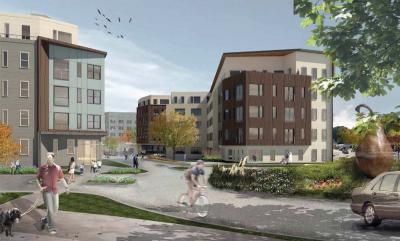October 22, 2015
 A rendering of the roundabout proposed for the intersection of Hancock and Pleasant streets at the base of the DOT Block development. The roundabout has been the subject of some confusion as the BRA solicits comments on the project from the public. Photo courtesy RODE ArchitectsTraffic concerns and congestion fears top the list of the public’s concerns regarding the DOT Block development, according to letters and emails submitted to the Boston Redevelopment Authority and provided to the Reporter. The public comment period for the project concluded on Oct. 9.
A rendering of the roundabout proposed for the intersection of Hancock and Pleasant streets at the base of the DOT Block development. The roundabout has been the subject of some confusion as the BRA solicits comments on the project from the public. Photo courtesy RODE ArchitectsTraffic concerns and congestion fears top the list of the public’s concerns regarding the DOT Block development, according to letters and emails submitted to the Boston Redevelopment Authority and provided to the Reporter. The public comment period for the project concluded on Oct. 9.
The project has sparked a high level of interest from residents and civic organizations as multiple versions of the plan were unveiled, with properties moving in and out of developer control.
The 16 public comments sent in via email, website, or snail mail were on par with projects of similar scale and iterations, said BRA spokesman Nicholas Martin.
“As far as community process and commitment, we have been out there for two years talking with everybody who wanted to talk to us,” said Catherine O’Neill, who represents the developers. As they pursued adding the three corner properties to their larger plan, at public request, for eight months, O’Neill said, “it was clear to me that everyone knew how hard we worked to get it.”
Many of the public comments expressed conditional support for DOT Block. Nicole Chandler, who works with a local non-profit, wrote that it would be good to see a change in the area, especially affordable housing for young professionals and, possibly, new grocery options.
Robert Mickiewicz, president of the Hancock Street Civic Association, submitted an early public comment letter and a later addition, both strongly objecting to the project.
One of the traffic concerns raised by Mickiewicz and echoed by others was the plan for installation of a roundabout at the intersection of Hancock and Pleasant streets. He wrote: “They plan on making it a rotary for traffic. Since city and state traffic departments consider rotaries dangerous, the developers now call it a “roundabout,” a British term for the same thing.”
In their turn, developers have emphasized the difference between the two types of traffic circles at public meetings. Rotaries, they say, allow for quick traffic flow and lane-weaving by their large design and direct entry angle, and speeds within them are commonly 30-40 miles per hour or higher.
Roundabouts are smaller, with entry points close to 90 degree angles that discourage speeding and limit speeds to under 25 miles per hour.
Increased congestion from those accessing the development has also been a concern, especially with regard to the area near Freeport Street. To evaluate transportation and circulation options, the BRA and the City’s Transportation Department are “working diligently to address those concerns with the developer,” Martin said in an email.
The authority has requested and received supplemental transportation filings for further evaluation.
O’Neill said developers have been acutely aware of traffic concerns throughout the project. “For this development to work, people have to live it, developers have to come to it, and we know no one is going to come to it if there is a traffic cluster,” she said.
Davida Andelman and Janet Jones, representing the Greater Bowdoin/Geneva Neighborhood Association and the Dorchester/Roxbury Labor Committee, respectively, submitted a letter in July requesting significant mitigations and public benefits in the surrounding neighborhoods.
Social advocacy groups raised similar issues — including that the design is not reflective of the neighborhood, and the need for diverse, local jobs associated with the project — at public meetings in the past.
However, few comments were submitted after July. The BRA received a supplemental filing on Sept. 15, and secured an extended comment period, which ended on Oct. 9. In reference to the supplemental filing, which detailed the reduced scope of the plans, only three letters and emails were submitted, two from Mickiewicz in opposition, and one from a new Dorchester resident in support.
Future community meetings are likely to involve discussions about changes in response to the feedback.
Topics:


